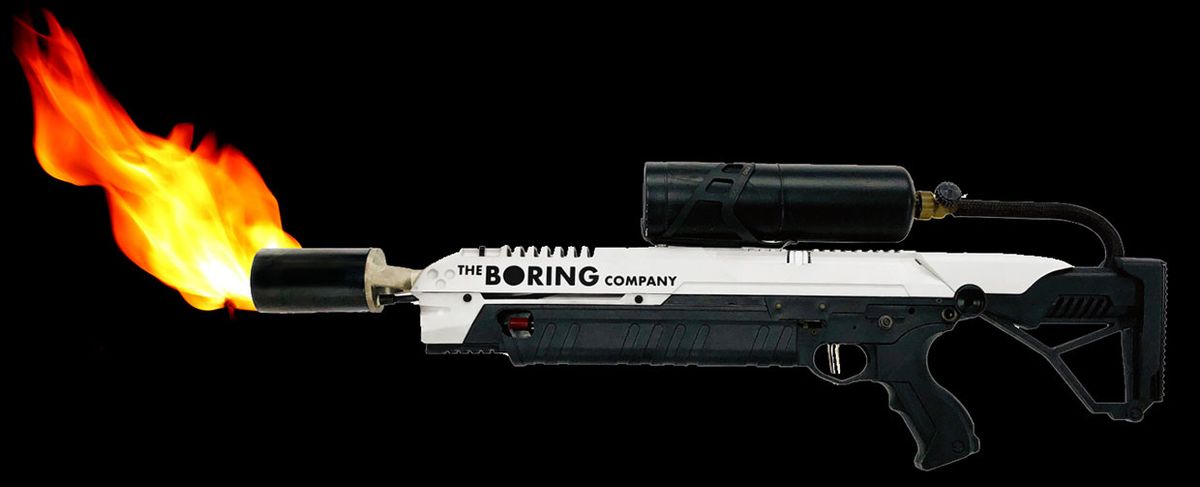Electric cars, space rockets...and flamethrowers? Elon Musk’s big ventures, Tesla and SpaceX, are recognized worldwide. Both companies started out with what seemed, at the time, a crazy idea. But now they are big companies, with little room for crazy.
Crazy, it seems, is where Musk’s Boring Company comes in. Musk started it in 2016 when, frustrated with Los Angeles traffic, he proposed an underground network of tunnels, starting with one to speed his commute to his offices at SpaceX. The Boring Company’s initial plan was to send individual cars (not subway trains) through the tunnels on high-speed electric sleds. In March, he pivoted, shifting the company’s focus to pedestrians and cyclists. He tweeted: “Will still transport cars, but only after all personalized mass transit needs are met. It’s a matter of courtesy & fairness. If someone can’t afford a car, they should go first.”
A network of underground tunnels for individual transportation isn’t science fiction. The Boring Company has already obtained permits to dig in Los Angeles and Maryland, and is a finalist in the bidding to build a system that will whisk passengers between downtown Chicago and O’Hare Airport in 20 minutes or less. (Boring’s final proposal for this project is due 18 May.) And Musk has said via Twitter that he could vastly reduce the costs of building a new Transbay tunnel between San Francisco and the East Bay.
But the Boring Company is much more than a transit company. It’s become Musk’s personal playground—one he’s funded to the tune of more than $100 million. And it’s already had a few products on the market.
Like hats. A limited edition Boring Co. hat went on sale last year and sold 50,000 at $20 a hat. Selling hats might seem silly—but that’s a million dollars in revenue. And remember, there was once a time when Tesla was nothing but hats.

Then came the personal flamethrower. Who knows why, but the Boring Company this year racked up sales of 20,000 flamethrowers at US $500 each, along with what the company called “overpriced fire extinguishers.” (You know all the cool geeks will have them at Burning Man this year.)
And just last month, Musk started talking about building cyborg dragons. Nobody knows exactly what this means, but it does seem like a natural evolution from the flamethrower.
A more practical project on Boring’s drawing board is the LEGO-like building kit. Digging tunnels means a lot of waste rock to dispose of; Musk envisions that rock cut into standard blocks and sold ready for assembly.
By the way, the Boring Company is hiring. According to the company’s website, its current openings include software, electrical, mechanical, industrial automation, and reliability engineers. No details are available, but you have to believe that whatever you will be working on won’t be boring.
As I’m watching Musk toss ideas into his Boring blender, I’m reminded of another rather creative entrepreneur, Nolan Bushnell of Atari fame. In 1981, Bushnell opened up Catalyst Technologies in Sunnyvale. Officially, Catalyst was a startup incubator—but most of the ideas being incubated came out of Bushnell’s own imaginings and the funding mostly came out of his own pocket. In other words, it was a lot more like Boring than what comes to mind when we think of an incubator today. Catalyst’s projects included a car navigation system, personal robots, and interactive television before almost anybody thought any of this was possible. “I read science fiction, and I wanted to live there,” Bushnell told Fast Company last year. Sound like Musk, much?
Tekla S. Perry is a senior editor at IEEE Spectrum. Based in Palo Alto, Calif., she's been covering the people, companies, and technology that make Silicon Valley a special place for more than 40 years. An IEEE member, she holds a bachelor's degree in journalism from Michigan State University.



